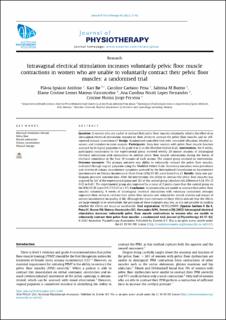| dc.contributor.author | Antônio, Flávia Ignácio | |
| dc.contributor.author | Bø, Kari | |
| dc.contributor.author | Bueno, Sabrina M. | |
| dc.contributor.author | Mateus-Vasconcelos, Elaine Cristine Lemes | |
| dc.contributor.author | Fernandes, Ana Carolina Nociti Lopes | |
| dc.contributor.author | Ferreira, Cristine Homsi Jorge | |
| dc.contributor.author | Pena, Caroline Caetano | |
| dc.date.accessioned | 2022-03-22T20:50:16Z | |
| dc.date.available | 2022-03-22T20:50:16Z | |
| dc.date.created | 2022-01-03T09:43:40Z | |
| dc.date.issued | 2022 | |
| dc.identifier.citation | Journal of Physiotherapy. 2021, 68(1), Side 37-42. | en_US |
| dc.identifier.issn | 1836-9553 | |
| dc.identifier.uri | https://hdl.handle.net/11250/2986914 | |
| dc.description | This is an open access article under the CC BY-NC-ND license (http://creativecommons.org/licenses/by-nc-nd/4.0/). | en_US |
| dc.description.abstract | Question: In women who are unable to contract their pelvic floor muscles voluntarily, what is the effect of an intravaginal electrical stimulation regimen on their ability to contract the pelvic floor muscles and on self-reported urinary incontinence?
Design: Randomised controlled trial with concealed allocation, blinded assessors and intention-to-treat analysis.
Participants: Sixty-four women with pelvic floor muscle function assessed by bi-digital palpation to be grade 0 or 1 on the Modified Oxford Scale.
Intervention: For 8 weeks, participants randomised to the experimental group received weekly 20-minute sessions of intravaginal electrical stimulation with instructions to attempt pelvic floor muscle contractions during the bursts of electrical stimulation in the final 10 minutes of each session. The control group received no intervention.
Outcome measures: The primary outcome was ability to voluntarily contract the pelvic floor muscles, evaluated through vaginal palpation using the Modified Oxford Scale. Secondary outcomes were prevalence and severity of urinary incontinence symptoms assessed by the International Consultation on Incontinence Questionnaire on Urinary Incontinence-Short Form (ICIQ-UI-SF) score from 0 to 21.
Results: Sixty-one participants provided outcome data. After the intervention, the ability to contract the pelvic floor muscles was acquired by 36% of the experimental group and 12% of the control group (absolute risk difference 0.24, 95% CI 0.02 to 0.43). The experimental group also improved by a mean of 2 points more than the control group on the ICIQ-UI-SF score (95% CI 0.02 to 3.97).
Conclusion: In women who are unable to contract their pelvic floor muscles voluntarily, 8 weeks of intravaginal electrical stimulation with voluntary contraction attempts improved their ability to contract their pelvic floor muscles and reduced the overall severity and impact of urinary incontinence on quality of life. Although the main estimates of these effects indicate that the effects are large enough to be worthwhile, the precision of these estimates was low, so it is not possible to confirm whether the effects are trivial or worthwhile. | en_US |
| dc.language.iso | eng | en_US |
| dc.subject | electrical stimulation therapy | en_US |
| dc.subject | muscle contraction | en_US |
| dc.subject | pelvic floor | en_US |
| dc.subject | physical therapy | en_US |
| dc.subject | urinary incontinence | en_US |
| dc.title | Intravaginal electrical stimulation increases voluntarily pelvic floor muscle contractions in women who are unable to voluntarily contract their pelvic floor muscles: A randomised trial | en_US |
| dc.type | Peer reviewed | en_US |
| dc.type | Journal article | en_US |
| dc.description.version | publishedVersion | en_US |
| dc.rights.holder | © 2021 Australian Physiotherapy Association | en_US |
| dc.source.pagenumber | 37-42 | en_US |
| dc.source.volume | 68 | en_US |
| dc.source.journal | Journal of Physiotherapy | en_US |
| dc.source.issue | 1 | en_US |
| dc.identifier.doi | 10.1016/j.jphys.2021.12.004 | |
| dc.identifier.cristin | 1973502 | |
| dc.description.localcode | Institutt for idrettsmedisinske fag / Department of Sports Medicine | en_US |
| cristin.ispublished | true | |
| cristin.fulltext | original | |
| cristin.qualitycode | 1 | |
